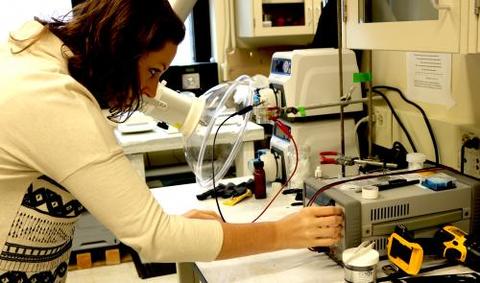
Monday, November 13, 2017
The School of Engineering and Applied Sciences recently featured the achievements of the work done by Desiree Plata, Center’s Associate Director for Research, on the extraction and reuse of rare metals from electronic devices.
Recycling the valuable rare earth metals found in advanced electronics from smartphones to plasma screen TVs has been a challenge for both manufacturers and environmental groups. Yale researchers, though, have developed a technology that could recover these materials for reuse.
Desiree Plata, the John J. Lee Assistant Professor of Chemical and Environmental Engineering, and Megan O’Connor, a former grad student in Plata’s lab, along with co-author Riley Coulthard, have built an electrochemical precipitation device that uses carbon nanotube filters to separate different elements found in e-waste and electronics manufacturing streams. In addition to recently publishing the results of their research in the Royal Society of Chemistry, O’Connor has started a company, Nth Cycle, based on the device and is in the process of developing and testing prototypes that work on a larger scale.
By applying different voltages, the researchers are able to separate metals based on each of the material’s potential for acquiring electrons - a phenomenon known as reduction - and/or the metal’s solubility in water. Applying a lower voltage, for instance, allows them to collect bulk metals, such as copper and nickel. A higher voltage selects for the rare earth metals common in electronics, which currently are almost never recovered from e-waste. In one test, for example, copper and europium were mixed together and pumped into the filtration device. By applying a low voltage to select for copper and doubling the voltage to select for europium, the researchers were able to separate and recover the two metals.
“We were really excited about this method because of its selective nature,” said O’Connor, who received her Ph.D. earlier this year. “We can actually separate two metals based on their reduction potentials and metal oxide solubilities.”
There’s a similar process in industry known as electrowinning, often used for copper refining, but it takes up a lot of space, and it doesn’t work with the waste streams that O’Connor and Plata are targeting. The method developed in the Plata lab works on such a small scale because it uses carbon nanotube filters, which have very high-surface areas that can collect low concentrations of metals. “By using the carbon nanotube filters, we can work at a much smaller total space scale and target these processes,” O’Connor said.
The device could potentially recoup a very valuable trove of useful material. A smartphone, for instance, contains multiple types of rare earth metal. One of the most prominent is neodymium, used for permanent magnets in many electronic devices and in wind turbines. O’Connor has been able to recover several milligrams of neodymium out of the smart phone magnets she has tested. The same devices also contain terbium, europium, and the bulk metals iron and copper.
The next step for developing the technology is testing it at the pilot scale to see if its strong performance translates to larger scale applications. “This is an emerging market, so we’re still trying to figure out the adoption strategy that we’re going to have,” she said. Plata added that electronics manufacturers are trying to proactively improve material efficiency and have more control over the metal supply chain, but few technologies can recover these metals of interest in high purity, in a cost-effective way with a low environmental impact.
“We’re hoping to provide that technical capability with this invention and, in doing so, help redefine e-wastes to be viewed as resources instead,” she said.
